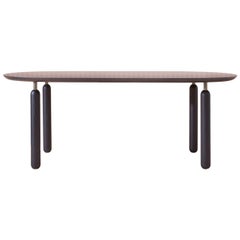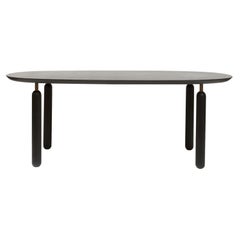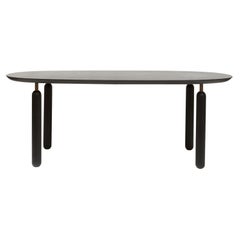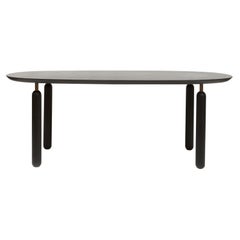Ellipse Table By Matteo Zorzenoni
2010s Italian Modern Dining Room Tables
Wood
21st Century and Contemporary Italian Modern Tables
Wood
21st Century and Contemporary Italian Modern Tables
Wood
21st Century and Contemporary Italian Modern Dining Room Tables
Wood
People Also Browsed
Vintage 1970s Danish Scandinavian Modern Chandeliers and Pendants
Aluminum
21st Century and Contemporary Brazilian Modern Dining Room Chairs
Wood
21st Century and Contemporary Swedish Mid-Century Modern Table Lamps
Textile
21st Century and Contemporary Portuguese Organic Modern Center Tables
Travertine
2010s Mexican Modern Armchairs
Fabric, Wicker, Hardwood
21st Century and Contemporary American Scandinavian Modern Wall Lights a...
Nickel, Brass
21st Century and Contemporary Brazilian Modern Armchairs
Bouclé
2010s Italian Modern Chandeliers and Pendants
Metal, Brass
21st Century and Contemporary Portuguese Modern Wall Mirrors
Mirror, Lacquer
21st Century and Contemporary Italian Chandeliers and Pendants
Brass
21st Century and Contemporary Mexican Mid-Century Modern Table Lamps
Fiberglass, Linen, Fabric, Wood
2010s South African Minimalist Pedestals
Wood
21st Century and Contemporary Portuguese Modern Console Tables
Travertine, Marble, Brass
21st Century and Contemporary Portuguese Modern Benches
Velvet, Wood, Lacquer, Fabric
2010s Canadian Modern Wall Lights and Sconces
Brass
21st Century and Contemporary Portuguese Modern Benches
Velvet, Wood, Ebony
Matteo Zorzenoni for sale on 1stDibs
Known for his innovative style and ongoing exploration of the potential of materials, Matteo Zorzenoni has garnered critical acclaim as one of Italy’s most talented, up-and-coming furniture designers.
Born in 1978 in Treviso, Zorzenoni studied art and design at the Art Institute before he attended IED (Istituto Europeo di Design) in Venice, graduating in 2001 with a degree in industrial design. After graduation, Zorzenoni worked at the Luav University of Venice for several years as an assistant for professors and designers Riccardo Blumer, Denis Santachiara and Marc Sadler, and later as a lecturer.
From 2004 to 2008, Zorzenoni worked as a consultant for studio Fabrica di Benetton, then began a long-term collaboration with Spanish furniture designer Jaime Hayon. Together, Zorzenoni and Hayon head the Italian branch of Fabrica.
When creating his modern furniture designs, Zorzenoni focuses on unlocking the potential of materials such as glass, marble, concrete and metal — elements he incorporates in many of his pieces. His inventive use of materials has led to several high-profile collaborations with notable European manufacturers. For instance, Zorzenoni designed the Crystal Ball vase for Italian company Cappellini, a collection of marble coffee tables called Chap for manufacturer Miniforms and, for MM Lampadari, a series of elegant and sculptural chandeliers, floor lamps, table lamps and decorative lighting.
Zorzenoni’s most prolific collaboration to date is with Italian furniture brand Scapin Collezioni. For Scapin, he has designed several of his most popular pieces such as the Cantilever wood and marble side tables, Ellipse dining room tables, distinctive Settebello sideboards and credenzas, the Òblo cabinet and the Bent, Clip and Cathedral mirrors.
Throughout his design career, Zorzenoni has participated in several exhibitions worldwide including the London Design Festival, Triennale di Milano, MAXXI in Rome, the Biennale of Architecture in Venice and more.
On 1stDibs, discover a range of Matteo Zorzenoni tables, case pieces and storage cabinets and lighting.
A Close Look at Modern Furniture
The late 19th and early 20th centuries saw sweeping social change and major scientific advances — both of which contributed to a new aesthetic: modernism. Rejecting the rigidity of Victorian artistic conventions, modernists sought a new means of expression. References to the natural world and ornate classical embellishments gave way to the sleek simplicity of the Machine Age. Architect Philip Johnson characterized the hallmarks of modernism as “machine-like simplicity, smoothness or surface [and] avoidance of ornament.”
Early practitioners of modernist design include the De Stijl (“The Style”) group, founded in the Netherlands in 1917, and the Bauhaus School, founded two years later in Germany.
Followers of both groups produced sleek, spare designs — many of which became icons of daily life in the 20th century. The modernists rejected both natural and historical references and relied primarily on industrial materials such as metal, glass, plywood, and, later, plastics. While Bauhaus principals Marcel Breuer and Ludwig Mies van der Rohe created furniture from mass-produced, chrome-plated steel, American visionaries like Charles and Ray Eames worked in materials as novel as molded plywood and fiberglass. Today, Breuer’s Wassily chair, Mies van der Rohe’s Barcelona chair — crafted with his romantic partner, designer Lilly Reich — and the Eames lounge chair are emblems of progressive design and vintage originals are prized cornerstones of collections.
It’s difficult to overstate the influence that modernism continues to wield over designers and architects — and equally difficult to overstate how revolutionary it was when it first appeared a century ago. But because modernist furniture designs are so simple, they can blend in seamlessly with just about any type of décor. Don’t overlook them.
Finding the Right Dining-room-tables for You
No matter your furniture style of choice, a shared meal is one of life’s true rewards. Why not treat your family and friends to a luxurious dining experience? Browse our top picks to find the perfect antique, new or vintage dining room table for this important occasion.
Modern furniture design borrows significantly from the trends of yore, and this is especially apparent in dining tables. Ancient Egyptians made practical use of the earliest four-legged tables of wood and rock — their models bear striking similarity to the dining tables of today — while common large medieval dining room tables in England were made of oak or elm. Romans and Greeks, renowned for big banquets that involved entertainment as well as good food, used early dining room tables made of marble or wood and metals such as bronze for meals.
On 1stDibs, find a range of dining room tables that offers no shortage of options to accommodate modest interiors, midsize family homes and even lavish banquets (entertainment not included).
Beginning in the mid-19th century, more American homes featured dining rooms, where families could gather specifically for a meal together. In the States, upper-class families were the first to enjoy dining room tables, which were the centerpiece of the dining room.
Dining room tables of the Victorian era were created in a range of revivalist styles inspired by neoclassical, Renaissance, Gothic and other traditions. Furnishings of the period were made of various woods, including oak, rosewood and mahogany, and referenced a variety of decorative arts and architectural motifs. Some dining room tables finished in the Rococo style feature gorgeous inlaid marble tabletops or other ornamental flourishes handcrafted by Parisian furniture makers of the 18th century.
In many modern spaces, there often isn’t a dining room separate from the kitchen — instead, they frequently share real estate in a single area. Mid-century modern dining room tables, specifically those created by designers such as Osvaldo Borsani, Edward Wormley and Alvar Aalto, are typically clean and uncomplicated designs for a dining area that’s adjacent to where the cooking is done. Furniture of this era hasn’t lost its allure for those who opt for a casual and contemporary aesthetic.
If you’re of the modern mindset that making and sharing meals should be one in the same — and perhaps large antique dining tables don’t mesh well with your style — consider a popular alternative. Working with a tighter space may mean that a round or oval dining room table, a design that references the festive meals of the medieval era, may be a better fit. Round dining room tables, particularly those that originated in the Art Deco period, still endure as a popular contemporary substitute for traditional rectangular dining tables. Giovanni Offredi’s Paracarro table for Saporiti Italia is a striking round table option that showcases the magnificent Italian industrial design of the 1970s.
Find a collection of antique, new and vintage dining tables on 1stDibs.



